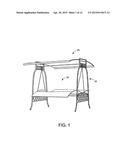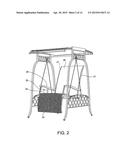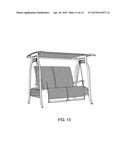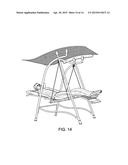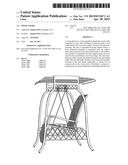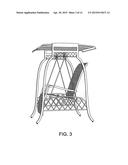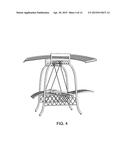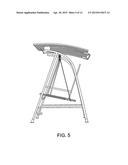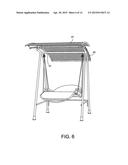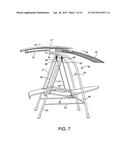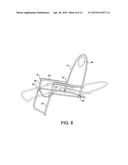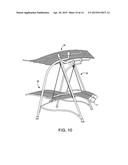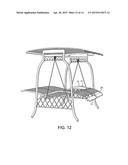Patent application title: Swing Chair
Inventors:
Samuel Chen (Shanghai, CN)
Samuel Chen (Shanghai, CN)
IPC8 Class: AA47C3025FI
USPC Class:
2971841
Class name: Chairs and seats with weather shield or insect protector (e.g., canopy, screen, etc.)
Publication date: 2015-04-30
Patent application number: 20150115671
Abstract:
A swing chair has a seat having three panels that are pivotally connected
to each other including a seatback panel, a seat middle panel, and a seat
lower panel. The seat is mounted for reclining. The seat is suspended
from the support frame. A front suspension member is suspended from the
support frame and connected to the seat middle panel. A rear suspension
member is suspended from the support frame and connected to the seat
behind a rear lower hinge. The rear lower hinge pivotally connects the
seatback panel to the seat middle panel. The seat optionally includes a
seat frame having fabric mounted to the seat frame. Optionally, a canopy
can be mounted above the swing chair. Preferably, an armrest is connected
in a four bar mechanism relationship with the seat.Claims:
1. A swing chair comprising: a. a seat having three panels that are
pivotally connected to each other comprising: a seatback panel, a seat
middle panel, and a seat lower panel, wherein the seat is mounted for
reclining; b. a support frame, wherein the seat is suspended from the
support frame; c. a front suspension member suspended from the support
frame and connected to the seat middle panel; and d. a rear suspension
member suspended from the support frame and connected to the seat behind
a rear lower hinge, wherein the rear lower hinge pivotally connects the
seatback panel to the seat middle panel;
2. The swing chair of claim 1, wherein the seat further comprises: a seat frame having fabric mounted to the seat frame.
3. The swing chair of claim 1, further comprising: an armrest connected in a four bar mechanism relationship with the seat.
4. The swing chair of claim 1, further comprising: a foot rest mounted at a lower portion of the seat lower panel.
5. The swing chair of claim 1, wherein the armrest front upper hinge is mounted to an inside surface of the seat armrest.
6. The swing chair of claim 1, further comprising: a canopy mounted above the swing chair.
7. The swing chair of claim 6, wherein the seat further comprises: a seat frame having fabric mounted to the seat frame.
8. The swing chair of claim 6, further comprising: a foot rest mounted at a lower portion of the seat lower panel.
9. The swing chair of claim 6, wherein the armrest front upper hinge is mounted to an inside surface of the seat armrest.
10. The swing chair of claim 6, further comprising: an armrest connected in a four bar mechanism relationship with the seat.
11. The swing chair of claim 10, wherein the seat further comprises: a seat frame having fabric mounted to the seat frame.
12. The swing chair of claim 10, further comprising: a foot rest mounted at a lower portion of the seat lower panel.
13. The swing chair of claim 10, wherein the armrest front upper hinge is mounted to an inside surface of the seat armrest.
14. The swing chair of claim 10, wherein the seat further comprises: a seat frame having fabric mounted to the seat frame; further comprising a foot rest mounted at a lower portion of the seat lower panel, wherein the armrest front upper hinge is mounted to an inside surface of the seat armrest.
Description:
[0001] This application is a non-provisional of U.S. provisional patent
application 61/897,505 by same inventor Samuel Chen entitled Swing Chair,
filed Oct. 30, 2013, the disclosure of which is incorporated herein by
reference.
FIELD OF THE INVENTION
[0002] The present invention is in the field of swing chairs.
DISCUSSION OF RELATED ART
[0003] The swing chair has been used for providing outdoor seating. Typically, swing chairs are popular during summer and spring seasons. Swing chairs allow users to enjoy the outdoors while being shielded from the sun by a canopy.
SUMMARY OF THE INVENTION
[0004] A swing chair has a seat having three panels that are pivotally connected to each other including a seatback panel, a seat middle panel, and a seat lower panel. The seat is mounted for reclining. The seat is suspended from the support frame. A front suspension member is suspended from the support frame and connected to the seat middle panel. A rear suspension member is suspended from the support frame and connected to the seat behind a rear lower hinge. The rear lower hinge pivotally connects the seatback panel to the seat middle panel. The seat optionally includes a seat frame having fabric mounted to the seat frame. Optionally, a canopy can be mounted above the swing chair. Preferably, an armrest is connected in a four bar mechanism relationship with the seat.
[0005] The object of the invention is to provide a reclining seat that can swing and is shielded from the sun for outdoor seating.
[0006] Optionally, the swing chair can have a foot rest. The seat lower panel can have a foot rest connected across the lower portion of the seat lower panel. The foot rest can be connected from a right side to a left side of the lower portion of the seat lower panel. Additionally, the armrest front upper hinge can be mounted to an inside surface of the seat armrest.
BRIEF DESCRIPTION OF THE DRAWINGS
[0007] FIG. 1 is a perspective view of a double chair in reclining position.
[0008] FIG. 2 is a perspective view of a single chair in upright position.
[0009] FIG. 3 is a side view of a single chair with the canopy retracted.
[0010] FIG. 4 is a side view of a single chair with the canopy extended.
[0011] FIG. 5 is a side view showing the canopy rails.
[0012] FIG. 6 is a front view showing the canopy rails.
[0013] FIG. 7 is a side view showing canopy extension.
[0014] FIG. 8 is a perspective view showing the reclining seat mechanism.
[0015] FIG. 9 is a perspective view of the single chair in reclined position with a foot rest.
[0016] FIG. 10 is a perspective view of the double chair in reclined position with foot rests.
[0017] FIG. 11 is a perspective view of the double chair in upright position with foot rests.
[0018] FIG. 12 is a perspective view of the double chair in reclined position with foot rests.
[0019] FIG. 13 is a perspective view of the double chair in upright position with foot rests.
[0020] FIG. 14 is a perspective view of a user in the single chair in reclined position with foot rests.
[0021] The following is a callout list of elements that can be used for referencing reference numbers of the drawings.
[0022] 20 Seat
[0023] 21 Seat Back
[0024] 22 Seat Middle
[0025] 23 Seat Lower
[0026] 24 Seat Armrest
[0027] 25 Seat Armrest Support
[0028] 26 Fabric
[0029] 27 Seat Frame
[0030] 28 Sway Bar
[0031] 29 Head Position
[0032] 31 Armrest Front Upper Hinge
[0033] 32 Armrest Rear Upper Hinge
[0034] 33 Armrest Front Lower Hinge
[0035] 34 Rear Lower Hinge
[0036] 40 Canopy
[0037] 41 Canopy Front Section
[0038] 42 Canopy Rear Section
[0039] 43 Canopy Rail
[0040] 44 Canopy Bushing
[0041] 50 Support Frame
[0042] 51 Front Right Vertical Support
[0043] 52 Front Left Vertical Support
[0044] 53 Rear Left Vertical Support
[0045] 54 Rear Right Vertical Support
[0046] 55 Left Horizontal Support
[0047] 56 Right Horizontal Support
[0048] 57 Upper Horizontal Support
[0049] 58 Rear Horizontal Support
[0050] 61 Front Left Suspension Member
[0051] 62 Rear Left Suspension Member
[0052] 63 Front Right Suspension Member
[0053] 64 Rear Right Suspension Member
[0054] 65 Left Suspension Spring
[0055] 66 Right Suspension Spring
[0056] 67 Left Suspension Connector
[0057] 68 Right Suspension Connector
[0058] 71 Foot Rest
[0059] 72 Inside Surface
[0060] 73 Foot Rest Pivots
[0061] 74 Locking Mechanism
DETAILED DESCRIPTION OF THE PREFERRED EMBODIMENT
[0062] The swing chair generally has a seat 20. The seat includes three pivotally connected panels comprising: a seatback 21, a seat middle 22 and a seat lower 23. Each seat panel is made of a seat frame 27 preferably made of metal, and a seat fabric 26 that is preferably UV resistant. The seat 20 has a seat armrest 24. The seat armrest 24 is pivotally connected to the seat back 21. The seat armrest is also pivotally connected to the seat armrest support 25. A sway bar 28 connects between the left and right sides of the seat middle 22. Seat armrest 24 forms a four bar mechanism being pivotally connected with the seat back 21, the seat middle 22, and the seat armrest support 25.
[0063] A user can recline on the seat. Reclining allows the user to lay almost prone. The seat is suspended from a frame. The support frame 50 has a front right vertical support 51, a front left vertical support 52, a rear left vertical support 53, and a rear right vertical support 54. The left horizontal support 55 connects between the rear left vertical support 53 and the front left vertical support 52. The right horizontal support 56 connects between the front right vertical support 51 and the rear right vertical support 54. The rear horizontal support 58 connects between the rear left vertical support 53 and the rear right vertical support 54. The vertical supports are generally vertical, and bent or angled inward so that they meet at an apex crossbar which is an upper horizontal support 57.
[0064] The seat 20 is hung from the upper horizontal support 57. The upper horizontal support 57 has a left suspension spring 65 and a right suspension spring 66 suspended from it. The left suspension spring 65 is connected to a left suspension connector 67. The right suspension spring 66 is connected to a right suspension connector 68. The right suspension connector 68 supports the front right suspension member 63 and the rear right suspension member 64. The left suspension member 67 supports the front left suspension member 61 and the rear left suspension member 62.
[0065] The left suspension members are connected to the left side of the seat 20. The right suspension members are connected to the right side of the seat 20. The front suspension members are connected to the front side of the seat 20. The rear suspension members are connected to the rear side of the seat 20. The rear suspension members are connected behind the rear lower hinges 34. The front suspension members are connected behind the armrest front lower hinges 33.
[0066] Therefore, the pair of rear lower hinges 34 are located between where the front suspension members and the rear suspension members connect to the seat 20.
[0067] The armrest has an armrest front upper hinge 31 connecting the seat armrest 24 to the seat armrest support 25. The seat armrest support 25 is rigidly connected to or is integrally formed with the seat lower 23. The pair of seat armrest rear upper hinges 32 connects the seatback 21 pivotally to the seat armrest 24. The armrest lower front hinges 33 pivotally connect the seat lower 23 and seat armrest support 25 to the seat middle 22. The seat middle 22 is pivotally connected to the seat back 21 at the rear lower hinges 34.
[0068] This invention can be made of metal or plastic or wood parts. The hinges can have angle limiting features. The hinges can be adjustable for tension control so that various resistance is provided to the reclining mechanism.
[0069] Additionally, the swing chair can have a foot rest. The seat lower panel 23 can have a foot rest 71 connected across the lower portion of the seat lower panel 23. The foot rest 71 can be connected from a right side to a left side of the lower portion of the seat lower panel 23. The foot rest 71 can mounted to pivot on foot rest pivots 73. A pair of foot rests can be used when a double chair for a pair of persons is being implemented. The foot rests in a double chair can be made to be freely movable.
[0070] Additionally, the armrest front upper hinge 31 can be mounted to an inside surface 72 of the seat armrest 24. Also, a locking mechanism 74 can connect the seat armrest 24 to the seat middle 22 or another part of the swing chair so that the backrest is locked in upright position to provide back support. The locking mechanism 74 can be formed as a bar that connects between various members to form a frame, or the locking mechanism 74 can be formed as a pin that inserts into a pair of holes to lock various members together to provide an upright position of the back support.
User Contributions:
Comment about this patent or add new information about this topic:

